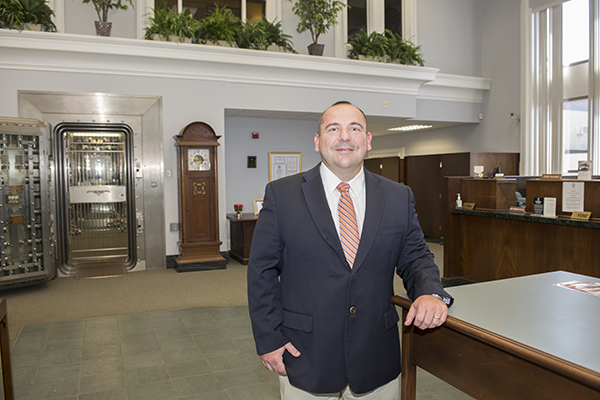During her 13 years of practicing law, Christy L. Murphy has been called “honey” and “sweetie” by older men when they were adversaries in legal cases.
“This is an old boys’ network,” says Murphy, 40, a partner at Bischoff Martingayle in Norfolk. “It’s hard to get people out of the mindset.”
Law firms are modernizing technology, cybersecurity and training, she says, “but many lack a concerted effort to modernize thinking about how to address and treat employees from a glass-ceiling perspective.”
Some people don’t think a glass ceiling exists; others think it’s no big deal, Murphy says, adding that she has encountered no issues at Bischoff Martingayle. “We are treated equally here, and other firms could learn from my current firm.”
Data show divergent courses — “stunning in their disparity” — for men and women in the legal profession, according to a recent report by the American Bar Association that explores why an alarming number of experienced women lawyers are leaving the profession.
Glass ceilings persist
More than 50% of law school graduates are women, but they represent less than 25% of equity partners in the Am Law 200, a ranking of the 200 largest U.S. firms, according to the ABA’s November 2019 report, “Walking out the Door,” by Roberta D. Liebenberg and Stephanie A. Scharf.
“Why the massive gap?” the authors write. “Why have women been fleeing law firms and the legal profession in droves?”
Female attorneys are as intellectually challenged in their work as men, according to the report, but they do not advance along the same trajectory. They report having less access than their male counterparts to the building blocks of success. In particular, female attorneys cite being overlooked for promotions, salary increases and business development opportunities.
Despite efforts by law firms to address such discrepancies, including endorsing women’s initiatives and creating women’s leadership networks, glass ceilings persist.
When it comes to the practice of law, gender is irrelevant, Murphy says. “If you’re dedicated, prepared and do really good work for your client, those are the things that make you successful in your career.”
Murphy is grateful for the senior female attorneys who came before her. “The path was forged for us,” she says, “and that path was much harder.”
While women continue to be underrepresented in management and equity positions, they are making headway.
Work-life balance

Monica T. Monday, managing partner of Gentry Locke Attorneys in Roanoke, was the first female lawyer to lead a large law firm in Virginia — a position she has held since 2013.
Other female partners have followed suit since then: Margaret Hardy, president of Sands Anderson and managing shareholder of its Fredericksburg office, and Courtney Paulk, president of Hirschler in Richmond.
But their numbers are few, considering that women have been entering the legal profession in large numbers for the past four decades.
“I can’t speak for everyone — only to my personal experiences,” Monday says. “I hope my story will show how all lawyers — whether women or men — can carve their own paths.”
Monday, 53, started at Gentry Locke in 1993 as a full-time lawyer and became a partner within six years.
When the opportunity arose for ownership, she was pregnant and her commute to Roanoke was more than one hour each way.
Monday’s son was born in 2004, the same year she became an owner. She worked part time and from home at least one day a week.
“The arrangement enabled me to balance my life,” Monday says. “The firm gave me the flexibility to do what would work for me.”
She was provided leadership opportunities, including serving as chairwoman of several committees, before advancing into management.
Firms invest time and resources to develop their employees, Monday says. “They do not want to lose lawyers.”
Attorneys should also ask for what they need to be successful, Monday says. “It’s important for law firms to be open and receptive to the needs of individual attorneys, male and female.”
The gender issue has been plaguing the profession for too long, she says. “In the 25 years I have been practicing law, it’s been the same conversation.”
Monday recalls speaking years ago with a senior female attorney who was lamenting the fact that women were leaving the profession.
To this day, that attorney’s words echo in Monday’s head: “We fought for you. We fought for you to be able to succeed.”
The trailblazers were women who graduated from law schools in the 1950s, 1960s and early 1970s.
Ruth Bader Ginsburg, 86, the second of only four female justices to serve on the U.S. Supreme Court, was rejected for a clerkship in her early years because of her gender.
“We have come a long way,” Monday says. “We need to have open conversations about how we can make this work for everyone.”
Mom or management?
Monday’s experience is unusual, says Alison M. McKee, an attorney at Kaufman & Canoles in Virginia Beach.
“Monica is a mom and a managing partner, but that is more the exception than the norm,” McKee says. “I don’t see a lot of women in top management or on executive committees.”

McKee, 59, started practicing law at Hunton & Williams (now Hunton Andrews Kurth) after graduating from the University of Virginia School of Law in 1984.
She considered leaving the firm after her second child was born, but she worked part time and became a partner in 1993. “Hunton & Williams was extremely flexible and willing to work with me,” recalls McKee, who resumed a full schedule but withdrew as a partner in 1996 after the birth of her third child. The firm encouraged her to stay on a part-time basis.
By the time her fourth child was born in 2001, her life was out of balance. She resigned and stayed home for five years to rear her two girls and two boys.
“Our profession is driven by numbers,” McKee says. To advance at large law firms, associate attorneys typically are required to hit 1,800 to 2,000 billable hours a year — “that’s a lot of hours” — and bring a targeted number of new clients to the firm.
“Because our jobs are so time-intensive and there are only so many hours in the day, especially when you’re taking care of kids, it’s hard to hit those numbers.”
McKee returned to work at Kaufman & Canoles in June 2008. President of the Virginia Bar Association, she will be only the fourth woman to hold the job in the trade group’s 132-year history.
McKee advocates alternative paths to leadership to create more gender equity. “Sometimes numbers don’t tell it all. Someone may meet the numbers but not have the best judgment to be a good manager. The numbers often tell a lot but you have to look at the bigger picture.”
Flexibility is key
Joy Fuhr, an equity partner at McGuireWoods in Richmond and national chair of the firm’s Women’s Lawyers Network, says she was able to navigate her career with the help of a nanny and a flexible work schedule.
“I haven’t done a heck of a lot else besides family and law for the past 25 years. I try to do those two things at a high level,” says Fuhr, 57.
Fifty percent of the top-tier income earners at McGuireWoods are women and 35% are department chairs, she says. The firm has an 80% retention rate of women who go through leadership training.
“Our numbers reflect our efforts,” Fuhr says. “The more diverse opinions and different perspectives, the better the overall results.”
Woody Fowler, CEO of Williams Mullen in Richmond, says recruitment, promotion and retention of female attorneys are priorities. The firm’s composition needs to reflect the communities and clients it serves, he says.
Williams Mullen has adopted family-friendly policies, including flexible work arrangements, and is revisiting how it can better help attorneys transition back to work after family leave, Fowler says.
Women partners hold about one-third of leadership positions at Williams Mullen, on par with the national industry average. But “we aspire to be better than average,” Fowler says.
Gender disparities most often arise in compensation decisions, says Ann Sullivan, founder of Sullivan Collins Law Group in Norfolk.
The boutique employment law firm was founded in 2013 for women attorneys looking for a better work/life balance and for those returning to work after a hiatus.
Pay discrepancies are not endemic to the legal profession, she says, but they are widespread among industries.
Sullivan supports open — not confidential — discussions about compensation to promote equity. Paid parental leave and flexible maternity and paternity leave would help stabilize pay inequities, she says.
According to the ABA’s “Walking out the Door” report, experienced female attorneys cited caretaking commitments as the top reason why they leave their firms.
“I know what the statistics are; I know what the pressures are,” says Cassandra “Sandy” C. Collins, a litigation partner at Hunton Andrews Kurth in Richmond.
Gender disparity never occurred to her when she was recruited fresh out of law school in 1989 to what was then Hunton & Williams.
“I’m a small-town girl,” Collins says. “I grew up in a town of 400 in eastern Kentucky. We had no lawyers in my family. My parents raised me to believe I could accomplish anything I put my mind to.”
The firm had four female partners when she started. Now close to a quarter of those attorneys, or about 90, are partners. Collins made partner in 1997.
“I fell into a practice with two fabulous male mentors,” she says. “I’ve had an incredible 30-year journey.”
The practice of law is challenging, regardless of gender, Collins says, but it’s tougher for women. “There hasn’t been as much progress and it hasn’t happened as quickly as we would like.”


 Half of the 282 overlapping BB&T and SunTrust branches in Virginia — those within two miles of each other — are expected to close, according to Atlantic Union’s calculations, and hundreds of jobs will be eliminated. That development is expected to create opportunities for Virginia banks like Atlantic Union to add customers, pick up or expand branch locations and hire talented people.
Half of the 282 overlapping BB&T and SunTrust branches in Virginia — those within two miles of each other — are expected to close, according to Atlantic Union’s calculations, and hundreds of jobs will be eliminated. That development is expected to create opportunities for Virginia banks like Atlantic Union to add customers, pick up or expand branch locations and hire talented people. Small and midsize business customers will be most affected by the merger, says Brian Plum, chairman of the Virginia Association of Community Banks and also CEO of Blue Ridge Bank in Luray.
Small and midsize business customers will be most affected by the merger, says Brian Plum, chairman of the Virginia Association of Community Banks and also CEO of Blue Ridge Bank in Luray.